
TEST KITCHEN With so many worlds turning up outside our solar system, it’s time to add some chapters to the planetary production manual.
Joseph Alessio
- More than 2 years ago
With a mortar and pestle, Christy Till blends together the makings of a distant planet. In her geology lab at Arizona State University in Tempe, Till carefully measures out powdered minerals, tips them into a metal capsule and bakes them in a high-pressure furnace that can reach close to 35,000 times Earth’s atmospheric pressure and 2,000° Celsius.
In this interplanetary test kitchen, Till and colleagues are figuring out what might go into a planet outside of our solar system.
“We’re mixing together high-purity powders of silica and iron and magnesium in the right proportions to make the composition we want to study,” Till says. She’s starting with the makings of what might resemble a rocky planet that’s much different from Earth. “We literally make a recipe.”
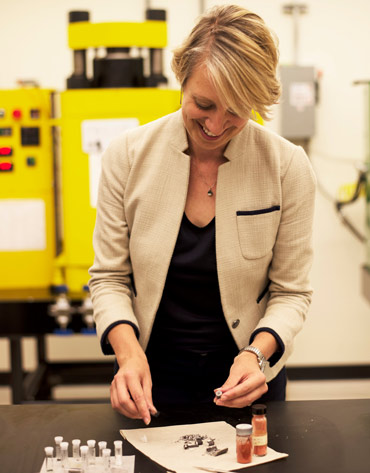
Scientists have a few good ideas for how to concoct our own solar system. One method: Mix up a cloud of hydrogen and helium, season generously with oxygen and carbon, and sprinkle lightly with magnesium, iron and silicon. Condense and spin until the cloud forms a star surrounded by a disk. Let rest about 10 million years, until a few large lumps appear. After about 600 million years, shake gently.
But that’s only one recipe in the solar systems cookbook. Many of the planets orbiting other stars are wildly different from anything seen close to home. As the number of known exoplanets has climbed — 3,717 confirmed as of April 12 — scientists are creating new recipes.
Seven of those exoplanets are in the TRAPPIST-1 system, one of the most exciting families of planets astronomers have discovered to date. At least three TRAPPIST-1 planets might host liquid water on their surface, making them top spots to look for signs of life (SN: 12/23/17, p. 25).
Yet those planets shouldn’t exist. Astronomers calculated that the small star’s preplanet disk shouldn’t have contained enough rocky material to make even one Earth-sized orb, says astrophysicist Elisa Quintana of NASA’s Goddard Space Flight Center in Greenbelt, Md. Yet the disk whipped up seven.
Sign up for our newsletter
We summarize the week's scientific breakthroughs every Thursday.
TRAPPIST-1 is just one of the latest in a long line of rule breakers. Other systems host odd characters not seen in our solar system: super-Earths, mini-Neptunes, hot Jupiters and more. Many exoplanets must have had chaotic beginnings to exist where we find them.
These oddballs raise exciting questions about how solar systems form. Scientists want to know how much of a planet’s ultimate fate depends on its parent star, which ingredients are essential for planet building and which are just frosting on the planetary cake.
NASA’s Transiting Exoplanet Survey Satellite, or TESS, which launched April 18, should bring in some answers. TESS is expected to find thousands more exoplanets in the next two years. That crowd will help illuminate which planetary processes are the most common — and will help scientists zero in on the best planets to check for signs of life.
Beyond the bare necessities
All solar system recipes share some basic elements. The star and its planets form from the same cloud of gas and dust. The densest region of the cloud collapses to form the star, and the remaining material spreads itself into a rotating disk, parts of which will eventually coalesce into planets. That similarity between the star and its progeny tells Till and other scientists what to toss into the planetary stand mixer.
“If you know the composition of the star, you can know the composition of the planets,” says astronomer Johanna Teske of the Carnegie Observatories in Pasadena, Calif. A star’s composition is revealed in the wavelengths of light the star emits and absorbs.
When a planet is born can affect its final makeup, too. A gas giant like Jupiter first needs a rocky core about 10 times Earth’s mass before it can begin gobbling up gas. That much growth probably happens well before the disk’s gas disappears, around 10 million years after the star forms. Small, rocky planets like Earth probably form later.
Finally, location matters. Close to the hot star, most elements are gas, which is no help for building planets from scratch. Where the disk cools toward its outer edge, more elements freeze to solid crystals or condense onto dust grains. The boundary where water freezes is called the snow line. Scientists thought that water-rich planets must either form beyond their star’s snow line, where water is abundant, or must have water delivered to them later (SN: 5/16/15, p. 8). Giant planets are also thought to form beyond the snow line, where there’s more material available.
But the material in the disk might not stay where it began, Teske says. “There’s a lot of transport of material, both toward and away from the star,” she says. “Where that material ends up is going to impact whether it goes into planets and what types of planets form.” The amount of mixing and turbulence in the disk could contribute to which page of the cookbook astronomers turn to: Is this system making a rocky terrestrial planet, a relatively small but gaseous Neptune or a massive Jupiter?
Birthplace
In the disk around a star, giant planets form beyond the “snow line,” where water freezes and more solids are available. Turbulence closer in knocks things around.
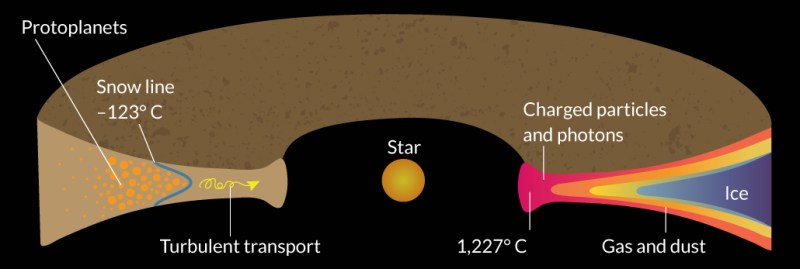
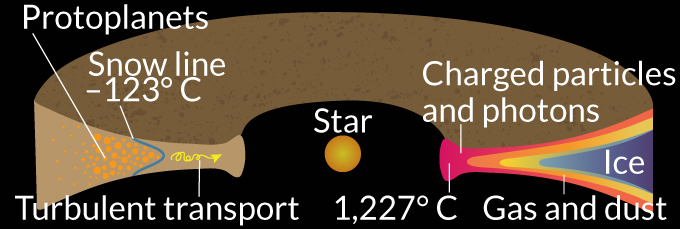
Source: T. Henning and D. Semenov/Chemical Reviews 2013
Some like it hot
Like that roiling disk material, a full-grown planet can also travel far from where it formed.
Consider “Hoptunes” (or hot Neptunes), a new class of planets first named in December in Proceedings of the National Academy of Sciences. Hoptunes are between two and six times Earth’s size (as measured by the planet’s radius) and sidled up close to their stars, orbiting in less than 10 days. That close in, there shouldn’t have been enough rocky material in the disk to form such big planets. The star’s heat should mean no solids, just gases.
Hoptunes share certain characteristics — and unanswered questions — with hot Jupiters, the first type of exoplanet discovered, in the mid-1990s.
“Because we’ve known about hot Jupiters for so long, some people kind of think they’re old hat,” says astronomer Rebekah Dawson of Penn State, who coauthored a review about hot Jupiters posted in January at arXiv.org. “But we still by no means have a consensus about how they got so close to their star.”
Since the first known hot Jupiter, 51 Pegasi b, was confirmed in 1995, two explanations for that proximity have emerged. A Jupiter that formed past the star’s snow line could migrate in smoothly through the disk by trading orbital positions with the disk material itself in a sort of gravitational do-si-do. Or interactions with other planets or a nearby star could knock the planet onto an extremely elliptical or even backward orbit (SN Online: 11/1/13). Over time, the star’s gravity would steal energy from the orbit, shrinking it into a tight, close circle. Dawson thinks both processes probably happen.
Hot Jupiters are more common around stars that contain a lot of elements heavier than hydrogen and helium, which astronomers call metals, astronomer Erik Petigura of Caltech and colleagues reported in February in the Astronomical Journal. High-metal stars probably form more planets because their disks have more solids to work with. Once a Jupiter-sized planet forms, a game of gravitational billiards could send it onto an eccentric orbit — and send smaller worlds out into space. That fits the data, too; hot Jupiters tend to lack companion worlds.
Hoptunes follow the same pattern: They prefer metal-rich stars and have few sibling planets. But Hoptunes probably arrived at their hot orbits later in the star’s life. Getting close to a young star, a Hoptune would risk having its atmosphere stripped away. “They’re sort of in the danger zone,” Dawson says. Since Hoptunes do, in fact, have atmospheres, they were probably knocked onto an elliptical, and eventually close-in, orbit later.
One striking exception to the hot loner rule is WASP-47b, a hot Jupiter with two nearby siblings between the sizes of Earth and Neptune. That planet is one reason Dawson thinks there’s more than one way to cook up a hot Jupiter.
Rock or gas
Hot Jupiters are so large that astronomers assume these exoplanets have thick atmospheres. But it’s harder to tell if a smaller planet is gassy like Neptune or rocky like Earth.
To make a first guess at a planet’s composition, astronomers need to know the planet’s size and mass. Together, those numbers yield the planet’s density, which gives a sense of how much of the planet is solid like rock or diffuse like an atmosphere.

The most popular planet detection strategies each measure one of those factors. The transit method, used by the Kepler space telescope, watches a star wink as the planet passes in front. Comparing the star’s light before and during the transit reveals the planet’s size. The radial velocity method, used with telescopes on the ground, watches the star wobble in response to a planet’s gravity, which reveals the planet’s mass.
Most of the stars observed by Kepler are too far away and too dim for direct, accurate measures of planet masses. But astronomers have inferred a size cutoff for rocky planets. Last June, researchers analyzing the full Kepler dataset noticed a surprising lack of planets between 1.5 and two times Earth’s size and suggested those 1.5 times Earth’s radius or smaller are probably rocky; two to 3.5 times Earth’s radius are probably gassy (SN Online: 6/19/17).
Dozens more planets have had their masses inferred indirectly, mostly those in multiplanet systems where astronomers can observe how planets tug on one another. From what astronomers can tell, super-Earths — planets between one and about 10 times Earth’s mass — come in a wide range of compositions.
The Kepler mission is about to end, as the spacecraft’s fuel is running out. TESS will pick up where Kepler leaves off. The new planet-hunting space telescope will revolutionize the study of super-Earth densities. It will scan 85 percent of the sky for bright, nearby stars to pick out the best planets for follow-up study. As part of its primary mission, TESS will find at least 50 planets smaller than Neptune that can have their masses measured precisely, too. “Having masses … will help us understand the compositions,” says Quintana, a TESS team member. “We can see: Is there a true transition line where planets go rocky to gaseous? Or is it totally random? Or does it depend on the star?”
Star power
All kinds of planets’ fates do, in fact, depend on the stars, Petigura’s recent work suggests. In a February report in the Astronomical Journal, he and colleagues measured the metal contents of 1,305 planet-hosting stars in Kepler’s field of view.
The researchers learned that large planets and close-in planets — with orbital periods of 10 days or less — are more common around metal-rich stars. But the team was surprised to find that small planets and planets that orbit far from their stars show up around stars of all sorts of compositions. “They form efficiently everywhere,” Petigura says.
That could mean that metal-rich stars had disks that extended closer to the stars. With enough material close to the star, hot super-Earths could have formed where they currently spin. The existence of hot super-Earths might even suggest that hot Jupiters can form close to the star after all. A super-Earth or mini-Neptune could represent the core of what was once a hot Jupiter that didn’t quite gather enough gas before the disk dissipated, or whose atmosphere was blown off by the star (SN Online: 10/31/17).
Weird water
Some scientists are looking to stars to reveal what’s inside a planet. The help is welcome because density is a crude measure for understanding what a planet is made of. Planets with the same mass and radius can have very different compositions and natures — look at hellish Venus and livable Earth.
Take the case of TRAPPIST-1, which has seven Earth-sized worlds and is 39 light-years away. Astronomers are anxious to check at least three of the planets for signs of life (SN: 12/23/17, p. 25). But those planets might be so waterlogged that any signs of life would be hard to detect, says exogeologist Cayman Unterborn of Arizona State. So much water would change a planet’s chemistry in a way that makes it hard to tell life from nonlife. Based on the planets’ radii (measured by their transits) and their masses (measured by their gravitational influence on one another), Unterborn and colleagues used density to calculate a bizarre set of interiors for the worlds, which the team reported March 19 in Nature Astronomy.
The TRAPPIST-1 planets have low densities for their size, Unterborn says, suggesting that their masses are mostly light material like water ice. TRAPPIST-1b, the innermost planet, seems to be 15 percent water by mass (Earth is less than 0.1 percent water). The fifth planet out, TRAPPIST-1f, may be at least half water by mass. If the planet formed with all that water already in it, it would have had 1,000 Earth oceans’ worth of water. That amount of water would compress into exotic phases of ice not found at normal pressures on Earth. “That is so much water that the chemistry of how that planet crystallized is not something we have ever imagined,” Unterborn says.
Size it up
Measuring a planet’s mass and radius gives astronomers a sense of planetary makeup. This plot compares the TRAPPIST-1 planets (purple) with Earth, Venus, an exoplanet named K2-229b and a couple of other worlds.
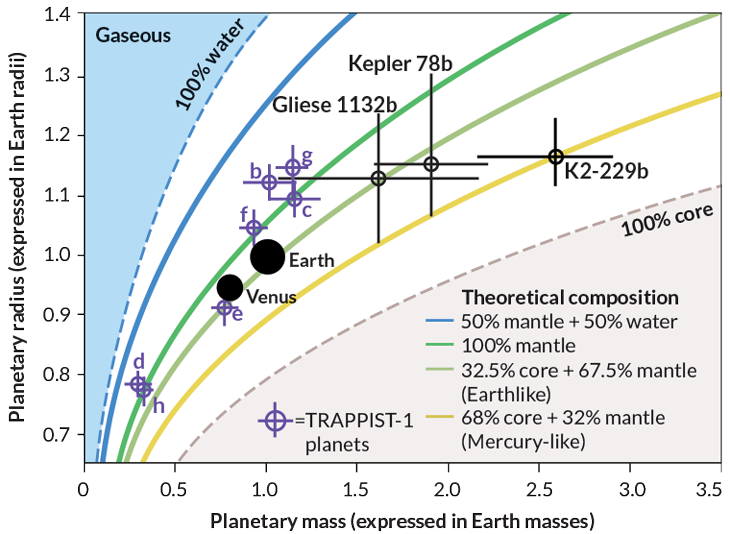
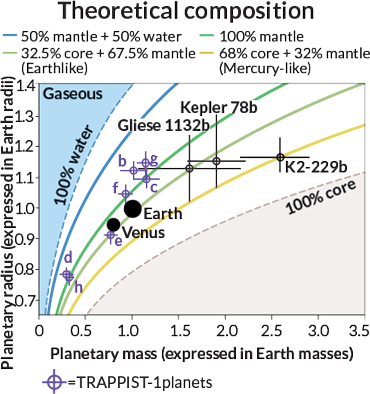
Source: A. Santerne et al/Nature Astronomy 2018
But there’s a glitch. Unterborn’s analysis was based on the most accurate published masses for the TRAPPIST-1 worlds at the time. But on February 5, the same day his paper was accepted in Nature Astronomy, a group led by astronomer Simon Grimm of the University of Bern in Switzerland posted more precise mass measurements at arXiv.org. Those masses make the soggiest planets look merely damp.
Clearly, Unterborn says, density is not destiny. Studying a planet based on its mass and radius has its limits.
Looking deeper
As a next step, Unterborn and colleagues have published a series of papers suggesting how stellar compositions can tell the likelihood that a group of planets have plate tectonics, or how much oxygen the planet atmospheres may have. Better geologic models may ultimately help reveal if a single planet is habitable.
But Unterborn is wary of translating composition from a star to any individual planet — existing geochemical models aren’t good enough. The recent case of K2-229b makes that clear. Astronomer Alexandre Santerne of the Laboratory of Astrophysics of Marseille in France and colleagues recently tried to see if a star’s composition could describe the interior of its newly discovered exoplanet, K2-229b. The team reported online March 26 in Nature Astronomy that the planet has a size similar to Earth’s but a makeup more like Mercury’s: 70 percent metallic core, 30 percent silicate mantle by mass. (The researchers nicknamed the planet Freddy, for Queen front man Freddie Mercury, Santerne wrote on Twitter.) That composition is not what they’d expect from the star alone.
Hints from the star
Based on its mass and radius, an exoplanet named K2-229b is about Earth’s size but more similar to Mercury in composition, astronomers suggest.
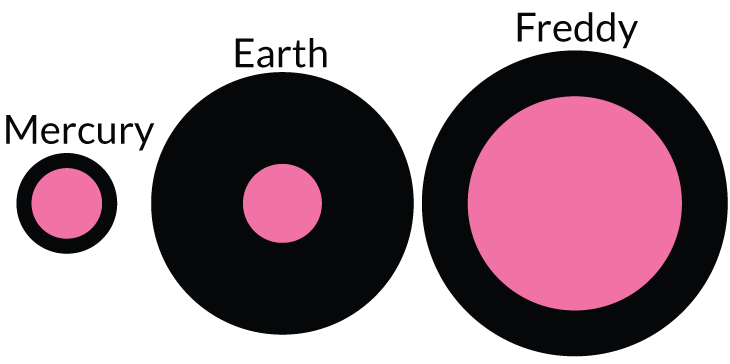
Source: A. Santerne et al/Nature Astronomy 2018
Geologic models need to catch up quickly. After TESS finds the best worlds for follow-up observations, the James Webb Space Telescope, due to launch in 2020, will search some of those planets’ atmospheres for signs of life (SN: 4/30/16, p. 32). For that strategy to work, Unterborn says, scientists need a better read on the exoplanet cookbook.
Christy Till’s pressure-packed test kitchen may help. Till is primarily a volcanologist who studies how magma erupting onto Earth’s surface can reveal conditions in Earth’s interior. “The goal is to start doing that for exoplanets,” she says.
Till and colleagues are redoing some foundational experiments conducted for Earth 50 years ago but not yet done for exoplanets. The experiments predict which elements can go into planets’ mantles and cores, and which will form solid crusts. (Early results that Till and grad student Mitchell Phillips presented in December in New Orleans at the American Geophysical Union meeting suggest that multiplying the sun’s magnesium-to-silicon ratio by 1.33 still bakes a rocky planet, but with a different flavored crust than Earth’s.)
Till uses three piston cylinders to squash and singe synthetic exoplanets for 24 hours to see what minerals form and melt at different pressures and temperatures. The results may help answer questions like what kind of lava would erupt on a planet’s surface, what would the crust be made of and what gases might end up in the planet’s atmosphere.
It’s early days, but Till’s recipe testing may mean scientists won’t have to wait decades for telescopes to get a close enough look at an exoplanet to judge how much like home it really is. With new cookbook chapters, Unterborn says, “we can figure out which stars are the best places to build an Earth.”







